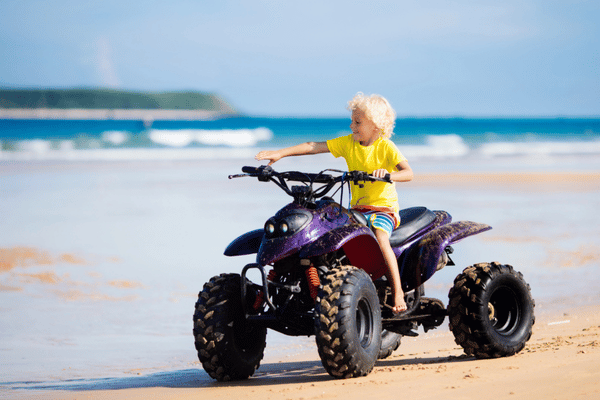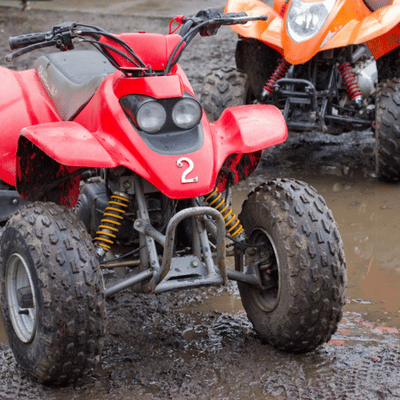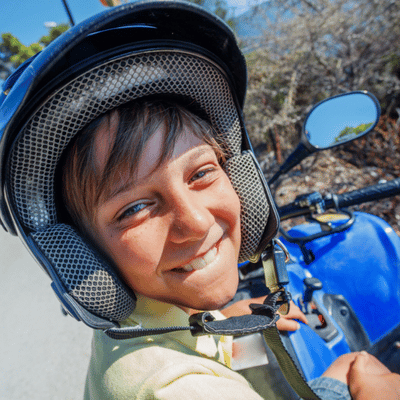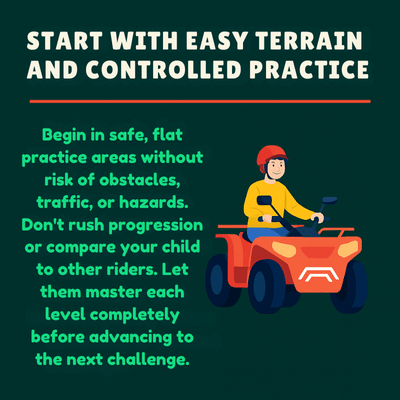
ATV riding brings thrills and adventure for kids under 13, but safety must come first. These powerful machines can cause serious injuries if not handled properly. Emergency rooms treat around 100,000 ATV-related injuries each year, with nearly 300 children under 16 getting injured in ATV park incidents over recent three-year periods.
Parents must take adequate safety steps to ensure that their child's first ride leaves a pleasant impression. With proper planning, you can reduce danger while increasing the fun. Here are some crucial ideas for getting your little rider ready for their ATV journey.

Finding the right ATV size is your first important decision. Too many injuries happen when children ride machines that are too large or powerful for them. Children under 6 years old should never ride ATVs. For older kids, stick strictly to youth model ATV categories designed for their specific age range.
Youth ATVs are categorized by motor size and measured in cubic centimeters. Children ages 6-11 should use ATVs under 70cc, while 12-15 year-olds can handle 70-90cc models. Always follow the manufacturer's age recommendation labels. Never let youngsters ride adult-size vehicles.
Age alone doesn't determine readiness. Consider your child's skill level, maturity, balance, and coordination. Can they ride a bicycle confidently? Do they follow instructions well? Children without good motor skills aren't ready for ATV demands.
Make sure the ATV physically fits your child. They should reach handlebars, throttle, and brake controls easily while sitting comfortably. An oversized machine creates dangerous handling problems.
Use built-in safety features like the speed limiter. This allows parents to restrict maximum speed by adjusting throttle response. Set the speed limiter to walking pace for first rides, then gradually increase as skills improve. Some models include remote engine kill switches that supervising adults can use if children lose control.

No matter the skill level or experience level, proper riding gear protects against risk of injuries when accidents happen. Begin with a quality helmet that satisfies safety precautions. Select a DOT-approved child helmet that fits comfortably without being too loose. The chin strap must be tightened tightly. A loose helmet will not provide that much protection during collisions.
Eye protection comes next. Goggles or shatterproof face shields provide protection from dust, pests, and flying debris. Good goggles seal around the face to prevent particles from getting behind the lenses offering great eye protection.
Sturdy gloves improve grip on handlebars while preventing blisters and protecting hands during falls. Over-the-ankle boots provide ankle support and good traction. Choose boots with non-slip soles that won't get caught on foot pegs.
Cover all exposed skin with long pants and long-sleeved shirts or riding jackets. Even minor spills can cause painful scrapes on bare arms and legs.
Consider additional protective gear for extra safety. A chest protector shields the torso from branches and flying debris. Elbow pads and knee protectors cushion joints during falls. While not always required, this extra protection builds confidence and prevents injuries.
Make riding gear rules non-negotiable. No helmet means no riding. If they want to ride, they wear all safety equipment every time.
Active adult supervision is absolutely essential for riders under 16. Never allow unsupervised riding. Stay close enough to intervene quickly if problems arise. For very young or new riders, consider walking alongside the ATV during first attempts.
Enroll in a safety training course before independent riding begins. Organizations like the ATV Safety Institute offer hands-on classes for youth riders plus online modules covering operation basics and safety guidelines. Some areas require safety certificates for young riders.
Even without formal training, conduct thorough safety instruction before the first ride. Show your child all ATV controls with the engine off. Explain the throttle, brakes, engine stop switch, and shifting mechanisms. Have them practice using controls until they understand each function.
Establish clear communication signals. Teach them that waving or yelling "stop" results in immediate stoppage. Use hand gestures or horn patterns while riding. Create a safety briefing regimen that includes rules and expectations for each expedition.
Follow local age limitations and regulations. Many states impose minimum age limits and required monitoring rules. Some mandate safety certificates or helmets for children. Research and obey all applicable laws in your riding area.

Begin in safe, flat practice areas without risk of obstacles, traffic, or hazards. Find open fields or designated beginner areas at an ATV park. Check that riding areas are free from rocks, tree stumps, or steep drop-offs.
Keep initial sessions short and at very low speeds. Have your child practice basic moves like starting, gentle acceleration, steering, and smooth braking. Coach them to apply throttle gradually rather than like an on-off switch.
Use the speed limiter to cap maximum speed at 5-10 mph until consistent control is demonstrated. Mastering basics at low speeds prevents accidents when speeds increase later.
Practice turning in both directions and stopping smoothly. Have them try figure-eight patterns at slow speeds to build turning confidence. Teach proper body positioning and weight shifting for different terrain types.
Gradually introduce slightly more challenging terrain only after flat-ground skills are solid. Each terrain type requires new skills, so progress slowly. Start with gentle, wide trails before attempting hills or tighter turns.
Maintain positive coaching throughout skill development. Don't rush progression or compare your child to other riders. Let them master each level completely before advancing to the next challenge.

Set non-negotiable ATV safety rules before any riding begins. During your safety briefing, go over these guidelines and explain why they are necessary.
Always wear full safety gear, which includes a helmet, goggles, gloves, and boots. One rider per ATV, unless specifically designed for passengers. Stay on certified off-road trails and avoid utilizing public roadways. Ride only during daylight hours and with excellent vision.
Follow all specified trail riding restrictions and speed limiters. Ride within ability limits without attempting stunts or racing. Stop immediately when unsure about terrain or situations.
Prepare for emergency situations by carrying a first aid kit and charged cell phone. Know basic injury treatment like cleaning cuts and treating sprains. Teach your child to hit the engine kill switch and signal for help if accidents occur.
Create simple emergency plans that children can remember. Practice what to do if they fall or lose control. Make sure they know to stop riding if something feels wrong with the vehicle or if they feel scared.
ATV riding will always carry some safety risks, but proper preparation dramatically reduces the chance of serious injuries. The right machine, correct protective gear, thorough training, and vigilant supervision create the foundation for positive experiences.
Remember that the goal is building confidence and skills while keeping everyone safe. Begin modestly and gradually advance based on demonstrated ability rather than age or peer pressure.
Consider visiting reputed facilities like Coral Crater's ATV park in Hawaii if your family is looking for professional guidance. These places offer expert tuition, proper safety equipment, and supervised conditions ideal for first-time riders.
With careful preparation and constant attention to safety standards, your child's first ATV adventure can create lasting memories while building valuable outdoor skills. Take your time, follow the rules, and focus on safe skill development rather than thrills.
Book your family's safe ATV adventure today at a certified facility near you. Professional instruction and proper safety measures ensure everyone returns home with smiles and stories to share.
